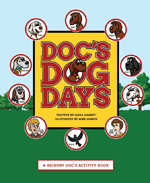
 |
Linda Harkey, a former educator and museum docent as well as a hunting dog enthusiast, writes children's books about the beloved and oft-visited topic of canine capers, making the old new again by featuring a specific breed close to her heart, German short-haired pointers. In this third book of her series, the adorable black-and-white illustrations by Mike Minick are begging to be colored and doodled upon with markers, pencils, or crayons, making this both an educational and a fun diversion likely to be appreciated by kids and their caregivers, parents, and teachers.
The activity book serves as a transition from picture book to chapter book, with a flash story and a full-page illustration in each spread. A single spread can be consumed as a separate lesson, story, or creative experience. The reading level and subject matter pertaining to the German shorthair breed and their tracking and hunting abilities is somewhat advanced in some stories in comparison to the coloring book illustrations, so younger children will need reading and information assistance as they enjoy their coloring. Some stories are simpler, less informative, tighter, and more playful than others, so this volume ultimately has broad appeal to a wide spectrum of kids: young non-readers, early readers, and more advanced readers who can tackle the more difficult text and the concepts themselves. Some stories are left purposely unfinished for development by students, with extra space on the page and prompted via a final question. There's also space in the coloring book illustrations for kids to add their own creative flourishes.
The anthropomorphic, dog-centric stories are heartfelt, light, and humorous, though occasionally a bit self-conscious and over explanatory, in the sense that illustrations typically play a role in "showing" some plot point in children's stories. Therefore, there are few visual surprises since the text tends to reiterate and upstage the pictorial action. The tales are set in specific locales, mostly Oklahoma and New Mexico. So, in addition to visiting the daily lives and adventures of hunting dogs, readers will also experience regional and environmental information, such as the wildlife they encounter and descriptions of landscapes.
The dogs' viewpoints are unique as they refer to their human couple at the Lazy Dog Hacienda as "Great One" and "Food Giver." Readers will also enjoy the various quirks of each character, such as Sadie's mealtime behavior and insistence that her food be served in a sectional bowl, or Zeke's desire to carry around a blanket during hunting season. The storybook dogs delight in their surroundings just as real dogs do, investigating anything attractive or new to them, such as Food Giver's ice cream bar, the reason Porcupine Pete has quills, or why the Lazy Dog Hacienda's owl is mysteriously hanging upside down one day. Readers are invited to explore these phenomena creatively, and no doubt they will also enjoy recounting their own dog stories in response to the book's tales. The universal appeal of companionship with dogs and curiosity about wild animal encounters, plus the invitation to process these creatively, is a big plus for this book as well as the series.
A 2020 Eric Hoffer Book Award Category Finalist
RECOMMENDED by the US Review
Next Focus Review
Previous Focus Review